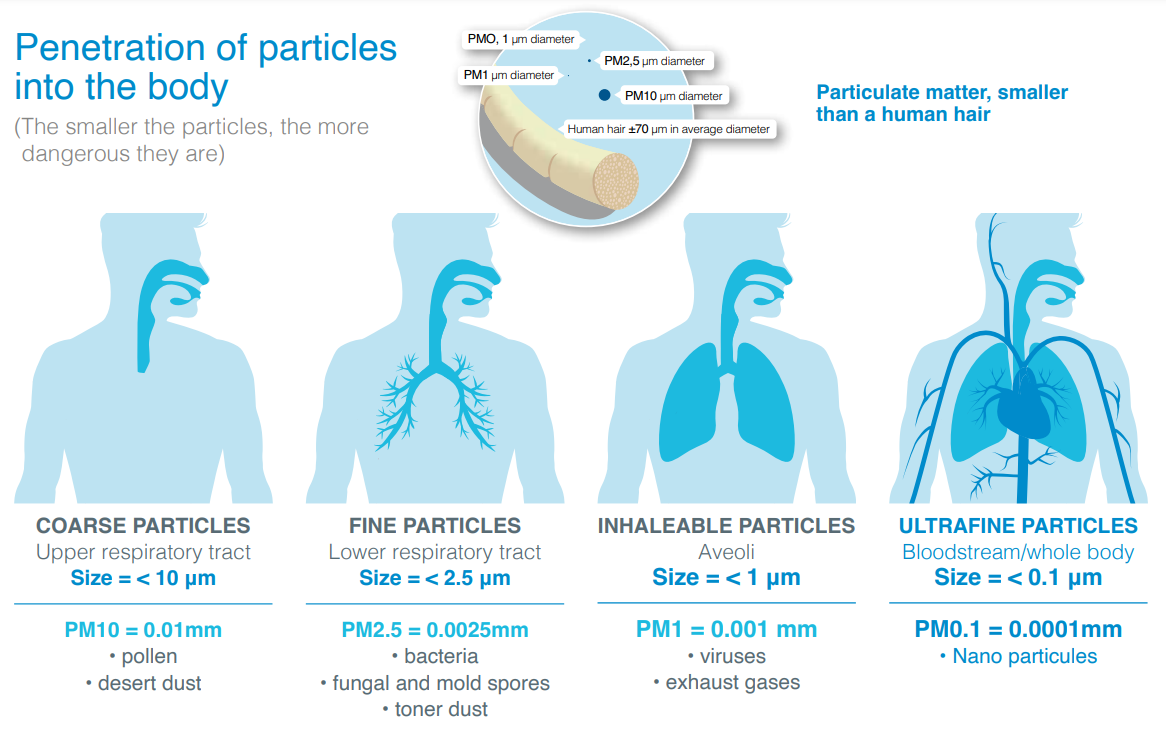PM1 Air Filter
PM1: The most hazardous kind of Particulate Matter.
A PM1 airfilter gives you the best protection against finedust. Remember that the smaller the particules are, the more dangerous they are as well. The World Health Organisation (WHO) has issued a stark new warning about deadly levels of air pollution in many of the world’s biggest cities. The WHO claims poor air quality is killing millions of people around the globe and is threatening to overwhelm health services.
This pollution consists of high amounts of PM1 particles and causes all kinds of health issues, varying from a simple but annoying cough to a stroke or heart attack. Today, particulate matter is by far the biggest environmental risk for public health according to the WHO.
Particulate matter (PM) is one of the major forms of air pollution created by the combustion of fossil fuels and the processing of industrial fabrics. It can also occur naturally, such as sea salt and soil dust. Particles can be emitted directly into the air (primary PM) or being formed in the atmosphere out of gaseous organic substances such as sulfur dioxide, nitrogen oxide, ammonia and methane (secondary particles).
Particulate Matter Categories (according ISO16890)
Particulate Matter (PM) is categorized by size: PM10 (0.01mm), PM2.5 (0,0025mm) and PM1 (0.001mm), of which the latter is the most harmful form. After inhalation affect the different sizes of particulate matter each body in a different way.
PM10: These are particles having an aerodynamic diameter of less than 10 micrometers. These particles are often referred to as “coarse particles” and is composed of fabric of roads and industrial, as well as particles formed by combustion. Depending on their size, the particles remain in the lungs.
PM2.5: Particles with an aerodynamic diameter less than 2.5 micrometers. These particles contain secondary aerosols and combustion particles. Fine particles can reach the pulmonary alveoli
PM1: Ultrafine particles with an aerodynamic diameter less than 1 micrometers. Ultra-fine dust is the most damaging variant of fine particles because the particles penetrate directly through the lungs into the bloodstream and are thus spread to the organs.
PM1 AirFilter giving you the best Protection against finedust
If the outdoor air isn’t filtered properly, a large amount of hazardous particles will find their way into our cardiovascular system. Combined with the already present particles in the indoor air, the Indoor Air Quality will drop to such unhealthy levels that one might as well move his desk outside: The outdoor air quality turns out to be higher in most cases.
The effect of Particulate Matter on the human body
The outer regions of our respiratory system are achieved only by tiny particles: PM1. These particles are about 0.01-1 microns in size. Whether these particles remain in the body depends on the size of the particulate matter and whether these particles can pass through the walls of our airways.
The different categories PM not all equally penetrate deep into the human body. The following infographic provides a graphical representation of the penetration by particulates classification, and explain you why it makes sense t choose a PM1 airfilter.

The importance of clean air
When we inhale, the air through our mouth or nose into the trachea rightly. The trachea is a sturdy tube which sit cartilage rings. These ensure that the airway is always open. He divides into two branches, called bronchi. At the ends of the smallest bronchi are the alveoli. The alveoli give the inhaled oxygen to the blood. The blood brings oxygen to all the sites in the body.
If the air is polluted harmful particles coming together with the oxygen during inhalation deep into the bronchi and then into the bloodstream. This can lead to heart disease and other serious health risks brings with it.





